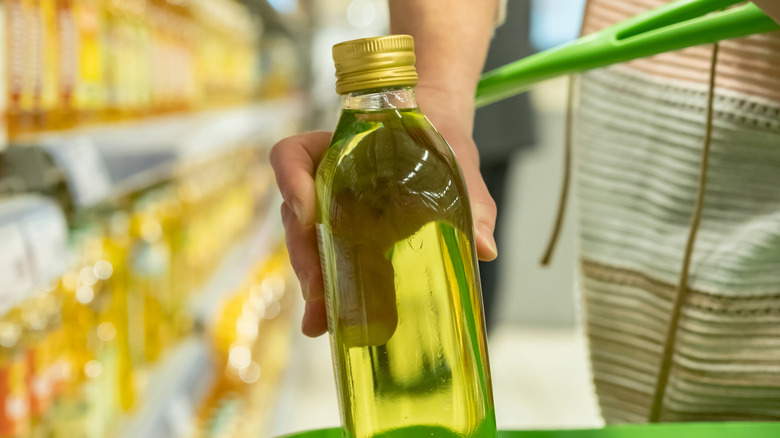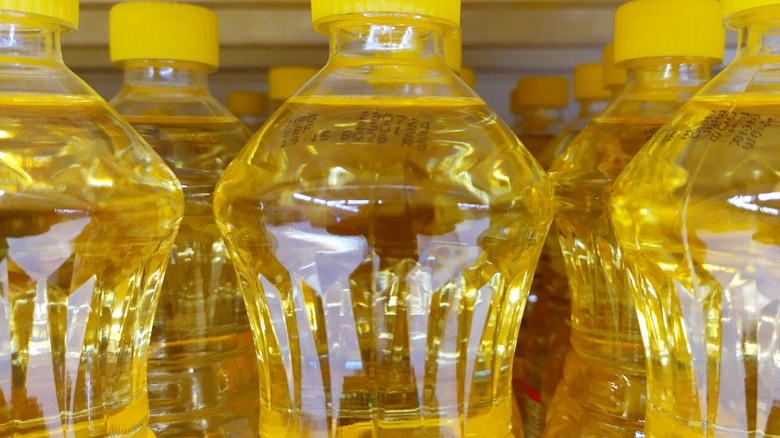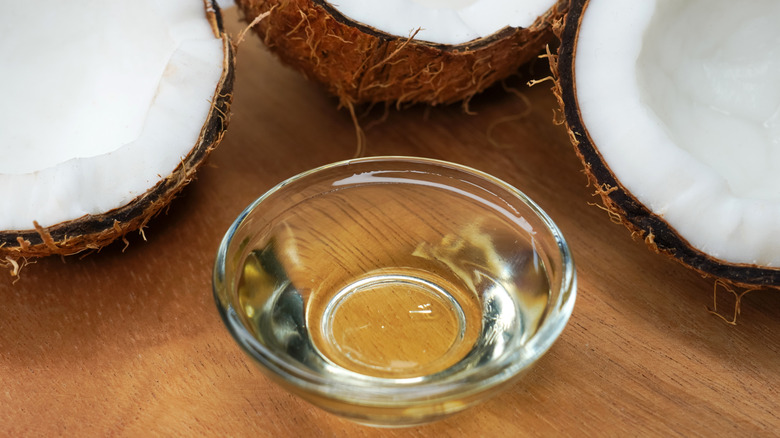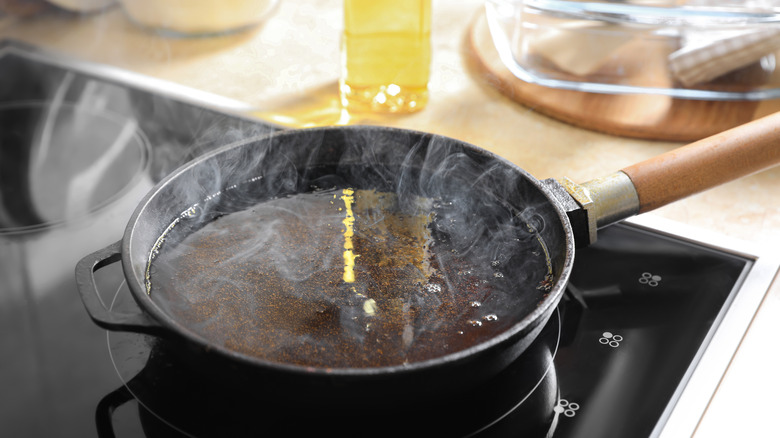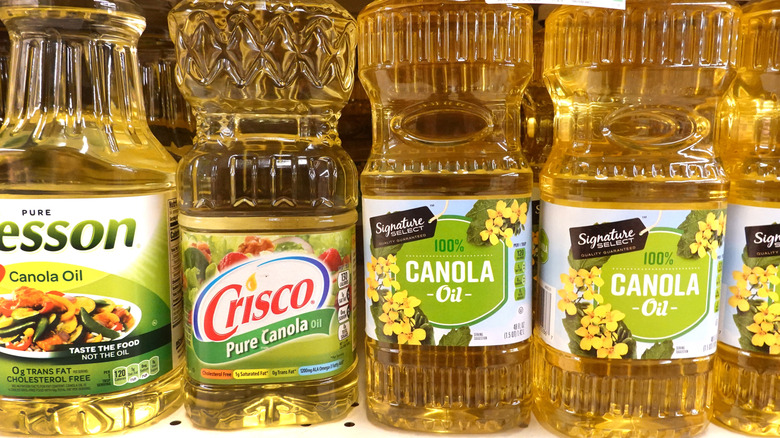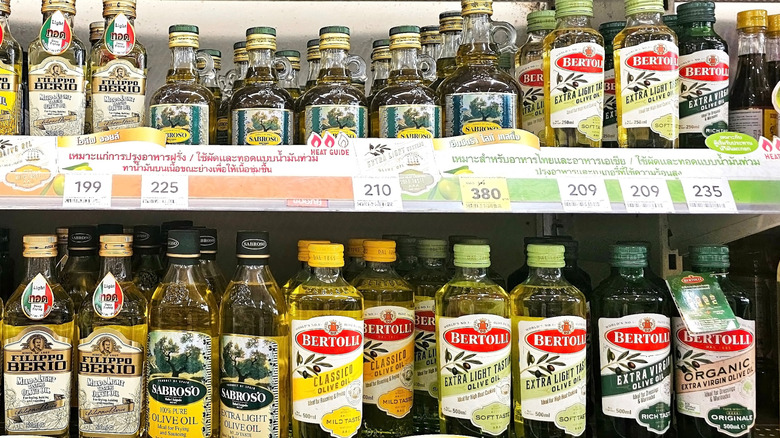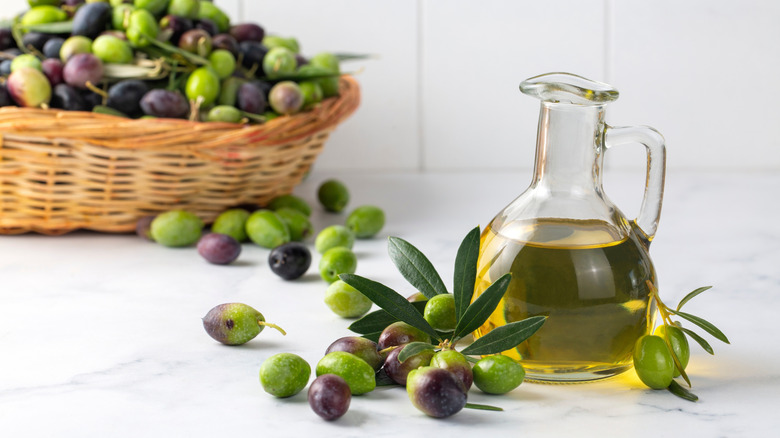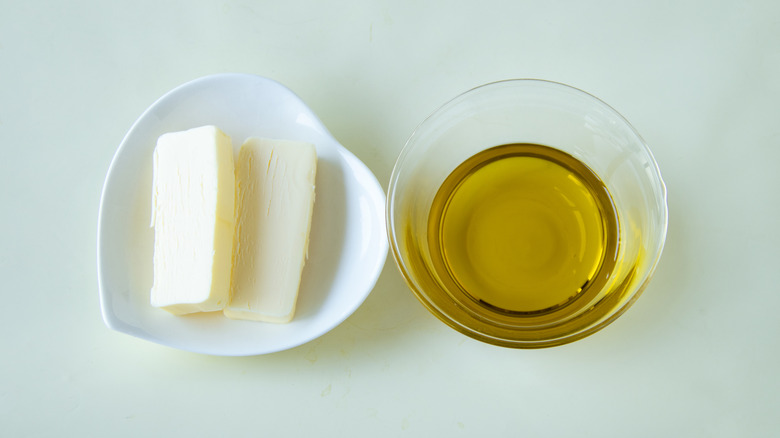12 Cooking Oil Myths You Should Stop Believing
For something that seems like a relatively mundane item in your pantry, cooking oil definitely comes with a side of controversy and a fair share of misinformation. Some declare that certain types of cooking oils are wildly unhealthy, full stop. Others say that you can't really trust certain oils to be what the packaging claims. Meanwhile, you just want to fry an egg or roast some veggies in the oven while ensuring that you're using the proper oil for the job, but you're inundated with messaging that all seems contradictory.
So how much do you really need to think about cooking oil? Is it really worth all the hubbub? Can't you just grab the cheapest option from the grocery store, or whatever you have on hand, regardless of things like smoke point or types of fat? Well, maybe, maybe not. Here are the common cooking oil myths being circulated that you should really stop believing, both for your health and your wallet.
Myth: Seed oils are inherently unhealthy
One of the biggest oil-related myths we've seen circulated is that seed oils are inherently unhealthy, and you should avoid them at all costs. Now, as the name suggests, seed oils include oils that are extracted from seeds. You probably know them more commonly as canola oil, soybean oil, sunflower oil, or safflower oil. While seed oil critics cite many issues – for instance, they cause inflammation, they contain linoleic acid, or they contain trans fat — the reality isn't as straightforward.
For starters, the claims surrounding linoleic acid and inflammation haven't been proven by scientific research. Additionally, even if some claim seed oils are reused multiple times at a high heat in certain places (like fast food restaurants or factories), one must have some nuance when it comes to those settings. After all, the average home cook isn't going to be using seed oils the same way a fast food chain or factory might.
Seed oils contain unsaturated fat, as well, rather than saturated fat (like what you'd find in butter). Furthermore, canola oil contains compounds that are beneficial to heart health, such as omega-3 fatty acids and phytosterols.
Myth: Coconut oil is a healthy option
Some claim that coconut oil is one of the healthier options when it comes to picking a cooking oil. However, just like you shouldn't accept the idea that seed oils are inherently unhealthy, you shouldn't accept the idea that coconut oil is healthful, full stop. he fact is that coconut oil contains mostly saturated fat.
In fact, just a single tablespoon of coconut oil has about 90% of the saturated fat that the American Heart Association recommends you consume in one day. This puts coconut oil about on par with butter or lard, at least in terms of heart health. Comparatively, olive oil is much lower in saturated fat.
Additionally, there's the issue that coconut oil is often pushed as a natural remedy for all sorts of health ailments — pain, lethargy, brain fog — when there's no real data to back that up. One of the big claims is that you can use coconut oil in a practice known as "oil pulling," wherein you swish around some oil in your mouth in place of brushing or flossing your teeth. However, again, there's no science to back up the idea that oil pulling actually fights gingivitis or other dental concerns.
Myth: The more expensive the oil, the healthier it is
The price of a bottle of cooking oil can reflect a lot — what type of oil it is or the potential quality, for example. But just because a bottle of cooking oil is more expensive doesn't mean it's healthier, particularly if you're comparing two bottles of the same type of oil.
Now, that being said, the price of olive oil — which is generally considered the healthiest cooking oil of all — has increased during the 2020s for myriad reasons. One of the main issues has been climate change. It's made olive oil production in regions such as the Mediterranean difficult, with rising temperatures and droughts leading to decreased olive yield.
The issue of olive oil shoplifting is on the rise, as well, along with criminal activity that impacts olive oil producers (such as gangs stealing reputable producers' olives and even olive trees). In other words, the price of olive oil isn't generally higher in 2025 solely because it's healthier.
Myth: When oil starts smoking, it becomes unhealthy
Olive oil has a low smoking point. This means that, if you're cooking at a high heat for an extended period of time, you'll notice your olive oil will start smoking faster than some other varieties of cooking oil. This has led some to believe the myth that olive oil isn't good to cook with, because when an oil starts smoking, it becomes unhealthy. However, olive oil contains phenols that help it resist breaking down even when it's smoking.
While some believe the chemical makeup of oil changes in such a way when it smokes that it becomes unhealthy, that isn't the case. More than that, cooking with olive oil can actually boost the health benefits of certain foods, like vegetables, as the oil may help our bodies absorb food's vitamins and antioxidants.
If you're wondering how the myth about smoking oil equaling health ramifications came about, some experts theorize that oils used at very high heats (thus resulting in smoking) are already used to cook generally less healthy items, such as deep-fried fast foods. The general public made the link between smoking oil and health issues, though the fact remains that it's not inherently bad for you.
Myth: Canola oil is banned in other countries
Some rumors have circulated over the years that canola oil is been banned in Europe as of 2025, with the belief that the European Union declared canola oil a carcinogen. However, this rumor is false. Then again, while Europe putting an all-out ban on canola oil is a rumor, it is true that the European Union does have stricter standards around canola oil.
Canola oil contains erucic acid, a naturally occurring contaminant linked to fat in the heart. As such, the European Union has set a limit on the maximum amount of erucic acid that canola oil can contain. Additionally, European farmers are not permitted to grow genetically modified canola. In contrast, canola oil produced elsewhere may be produced from genetically modified plants. It's worth noting that only the protein in canola is genetically modified, and when canola oil is produced, the proteins are removed — thereby making canola oil in general a non-GMO ingredient.
Furthermore, if you go to a grocery store in a European Union country and can't find any canola oil on the shelf, that's not automatic proof that the oil has been banned. Instead, the term "canola oil" isn't largely used in Europe, with producers instead calling it "rapeseed oil," as canola is a type of rapeseed plant.
Myth: Refined oils are unhealthy
When we say an oil is "refined," it merely means that it's been heat-treated. Yes, this process does reduce some of the naturally occurring health properties in some oils, but that doesn't mean that the oil itself is altogether unhealthy just because it's refined. The oil will still contain the monounsaturated and polyunsaturated fat that you would typically prefer over saturated fat.
Refined oils include vegetable, cottonseed, soybean, safflower, sunflower, peanut, canola, and grapeseed oils, as well as margarine. You can also buy refined olive oil. As alluded, when it comes to choosing a cooking oil at home, based on health, it really pays to think about how you're using the oil versus the type of oil.
Refined oils can also be affordable, healthy options for home cooking. It's when manufacturers or fast-food chains take advantage of these cheap oils and then reuse them over and over again, cooking at high temperatures in high-fat methods such as deep frying, that you run into health concerns.
Myth: You shouldn't store your oil in the fridge or freezer
Quick: Where is all your cooking oil right now? Probably in the pantry or a kitchen cabinet, right? It's an unrefrigerated item that doesn't need many storage considerations, after all. You probably have some cooking oil that you purchased months ago, and you're still not worried about it going bad.
Well, just because you're not worried about your cooking oil turning rancid, that doesn't mean that you shouldn't follow some oil storage best practices — and just because oil doesn't need to be refrigerated, that doesn't mean you should explicitly avoid storing it in the fridge. In fact, storing olive oil in the fridge or freezer can extend its shelf life, with research showing that storing olive oil at 59 degrees Fahrenheit extends its shelf life longer than had it been stored at 77 degrees Fahrenheit. Likewise, research shows oil stored at –4 degrees Fahrenheit maintains its quality better than oil stored at 39 degrees Fahrenheit.
If you want to freeze your olive oil, consider pouring it into an ice cube tray, for easier portioning later. It'll last for about 18 months. If the oil becomes cloudy over freezing, don't worry; that's normal. You can even freeze some leftover herbs in the oil, or chopped garlic or sun-dried tomatoes, for infused olive oil.
Myth: Cloudiness is a sign oil has gone bad
As mentioned, if you freeze or refrigerate your olive oil and it begins to look a little cloudy, have no fear. It's not a sign the oil has gone bad. Even if you've been keeping your oil in the pantry and it looks a little cloudy, that's no reason to worry.
So what exactly is it? If you see what looks like white sediments in your olive oil, it's usually a sign that the olive oil has been stored at a temperature just low enough for the oil's waxes to separate from the liquid. These white spots will go away as the temperature rises. Cloudiness, meanwhile, could indicate the producer didn't remove all of the olive from the oil; the leftover sediments mix with the oil and make it cloudy.
Some shoppers will even look specifically for olive oil that still contains these particles, seeing it as a marker of a more natural product. However, this unfiltered olive oil isn't likely to last as long as filtered olive oil, as the sediment that rests on the bottom of the olive oil accelerates oxidization, leading to rancid oil.
Myth: Light olive oil is lower in calories
If you're shopping and trying to eat a lower calorie diet, you may peruse the grocery aisles for anything with the word "light" in it. When it comes to cooking oil, you know it's going to add calories to your meal, so lighter is going to be better ... right? Unfortunately, no. If you're comparing olive oils and looking for the healthiest in the batch, don't reach for the light olive oil.
When it comes to olive oil, the word "light" doesn't actually refer to lower calories or lower fat. Instead, light olive oil is simply olive oil that's been refined so that it's lighter in color, odor, and flavor than its extra virgin counterparts. Processors can use a few tactics to remove these odors, colors, and flavors, including neutralization — in which the oil is treated with a substance such as lye or caustic soda — or bleaching.
Otherwise, if you're looking for the lowest-costing oil, rest assured that choosing the best olive oil will be easy. All olive oils are 120 calories per tablespoon, regardless of grade or processing. The only other type of oil that's lower in calories is coconut oil, which is 117 calories per tablespoon — but keep in mind that coconut oil contains a large degree of saturated fat.
Myth: Color is an indicator of olive oil quality
Don't make the mistake of thinking that just because an olive oil looks more or less "olive-y" in hue that it's a lower or higher-quality olive oil. From light yellow to dark green, olive oils run a spectrum of colors, and color does not tell you anything about quality (and, in fact, when industry tasters taste olive oil, they use a colored glass, so that their opinions can't be swayed by the oil's appearance!). The color can tell you other things, though, including variety of olive used, region the olive was grown in, climate the olive was grown in, how old the olives were when they were picked, processing methods, and more.
For example, olives that are picked earlier in the harvesting season are typically greener, so if your olive oil is very vibrantly green, it may be made with early-harvested olives. Additionally, if a green oil is stored for a significant amount of time, it may turn more golden as it ages.
One color you should pay attention to, though? The color of the bottle your olive oil is stored in. Clear bottles allow light to directly shine in on the olive oil, which can cause your olive oil to go bad, faster. Look for a darkly colored bottle or a container that's entirely opaque.
Myth: You shouldn't reuse frying oil
As we've already discussed, the continual use, over and over again, of oils at high heat, is a cause for concern for health experts. However, even if you reuse your frying oil at home a few times, you're not going to be doing so to the extent that fast food chains do. You won't use it to the extent that food manufacturers do, either. In other words, you can reuse frying oil at home without worrying about the potential health consequences — at least for a time.
Keep in mind that the risk of oil producing harmful compounds increases the more you use it. As such, it's recommended that you only reuse cooking oil up to three times. Additionally, try to keep your oil under 375 degrees Fahrenheit, and choose stable oils if you're going to reuse them, such as peanut, vegetable, canola, or safflower oil. Between uses, always strain the oil to remove food residue.
No matter how many times you've reused your oil, don't reuse it if it begins to appear dirty, or if it starts smoking before the oil's typical smoking point. Likewise, if it smells off? Go ahead and toss it.
Myth: You can use oil to raise butter's smoke point
Butter has one of the lowest smoke points out there — 350 degrees Fahrenheit — equal to coconut oil and some sesame and extra virgin olive oils. This means that butter's not going to be a great fit for any high heat cooking. If you want to, for example, roast some veggies at 425 degrees Fahrenheit in the oven, you really shouldn't coat those veggies in butter before tossing them in to cook (unless you want a kitchen full of smoke).
Some, though, try to get around this little fact of science by using oil to raise butter's smoke point. It's just a common myth that this works, though, potentially because, if you heat a quarter cup of oil and a quarter cup of butter, it will smoke overall less than if you heated a half cup of pure butter. However, the butter is still going to smoke at the same temperature. The butter's milk proteins still burn at 350 degrees Fahrenheit.
That all said, you can raise butter's smoke point, but not with oil. Instead, you have to remove the compounds that are burning in the first place: milk proteins. When you do, you're left with ghee, which has a smoke point of upwards of 450 degrees Fahrenheit.
